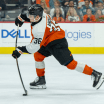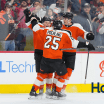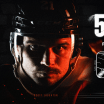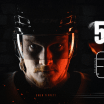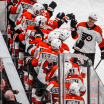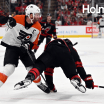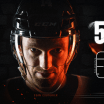At least on paper, the Second Round series between Alain Vigneault's Philadelphia Flyers (41-21-7 in the regular season, 7-2 in the postseason) and Barry Trotz's New York Islanders (35-23-10 regular season, 7-2 postseason) shapes up to be a low-scoring, grind-it-out contest.
The Flyers have allowed only 16 goals across their nine playoff games to date, while the Islanders have given up just 15. The two teams were also very close in regular season goals against average; the Flyers were tied for 7th at 2.77 and the Islanders were next at 2.79 goals allowed per game.
Philly was the better regular season offensive time, scoring 3.29 goals per game while the Islanders were in the bottom one-third of the league at 2.79 goals per game. The Flyers ranked 7th offensively, while the Islanders ranked 22nd. However, that has reversed so far in the playoffs. The Isles have scored 30 postseason goals so far to the Flyers' 22.
As the old saying goes, there's a reason why hockey is played on ice and not on paper. What does tend to translate is this: team identities.
The Flyers pride themselves on being a well-balanced team that wins via depth, teamwide commitment to 200-foot play and giving their goalies a chance to, in turn, give the team a chance to win most nights.
The Islanders, one of the biggest and heaviest teams in the NHL, pride themselves on supporting their skilled players atop the lineup with a cadre of physically aggressive players, a teamwide commitment to shot-blocking and a similar approach to the Flyers in terms of giving its goaltender a fair chance at making saves on most of the shots that get through to him.
The following is an in-depth breakdown of the upcoming playoff series:
Tale of the Tape: Flyers vs. Islanders
A look at which team has the edge in specific categories of play
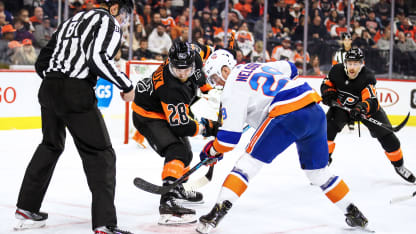
© Icon Sportswire/Getty Images
FLYERS FORWARDS VS. ISLANDERS FORWARDS
THE EDGE: Based on regular season play - the Flyers. Based on playoffs - the Islanders
THE EXPLANATION: If things play out as Vigneault wants it, the Flyers might have their No. 1 line, currently consisting of Selke Trophy nominee Sean Couturier centering Jakub Voracek on the right and Michael Raffl on the left, going head to head with Mathew Barzal's line with Anders Lee and Jordan Eberle. At some point, the Flyers may move Claude Giroux back from center to rejoin Couturier on his left wing.
Kevin Hayes' line, which finished the Montreal series with Joel Farabee on left wing and Travis Konecny on the right, might see a lot of Brock Nelson's line with Anthony Beauvillier and Islanders' leading playoff scorer Josh Bailey. This is a potentially troublesome matchup from a Flyers' standpoint, although Hayes individually was one of the Flyers' top players when the Montreal series was on the line and Farabee scored twice in that series. Getting more from Konecny, the Flyers, regular season scoring leader, is a big offensive key to the series for Philadelphia.
Giroux is generally more effective nowadays at left wing than at center, where he spent the bulk of his pre-2017 career. By necessity -- not just to spark their captain, but also trying to get James van Riemsdyk going, Vigneault had Giroux centering JVR and Scott Laughton in the latter part of the Montreal series. Laughton was on fire offensively during the round-robin but cooled off considerably in the Montreal series.
New York's third line, as of now, has veteran Derick Brassard on a line with trade deadline acquisition J-G Pageau and veteran role player Leo Komarov. Pageau, a versatile forward and reliable two-way player, was having a career year in Ottawa before the Islanders acquired him at the cost of 2020 first-round and second-round picks. He's been quite effective in the playoffs so far. The Flyers have had run-ins in the past with Komarov, particularly when the Estonian played for Toronto and viciously boarded Shayne Gostisbehere.
The Flyers' fourth line concluded the Montreal series with Derek Grant (moved down from the third line and over from center to left wing) on a line with veteran defensive center Nate Thompson and speedy grinder Tyler Pitlick on the right.
The Islanders' fourth line is something of a throwback to a now largely bygone era: a smash-mouth style with lots of size and muscle on the wings. Matt Martin is one of the NHL's most frequent hitters and is often in opponents' faces. Versatile center Casey Cizikas isn't big but is a very good penalty killer who can chip in some timely goals and is an agitating player and chirper.
The right wing spot will either be occupied by the aggressive and agitating Cal Clutterbuck (who has somehow found his way onto the scoresheet against the Flyers more than he has against any other NHL team, and by a significant margin). Clutterbuck was banged up in the Capitals series and may not be available for the start of this series. If he can't go, the next man up is the huge Ross Johnston (6-foot-5, 235 pounds), who is about as close to an old-school fourth line enforcer as exists in the NHL nowadays. Johnston has dressed in one playoff game so far.
FLYERS DEFENSE VS. ISLANDERS DEFENSE
THE EDGE:Dead Heat
THE EXPLANATION:Without Boychuk, an on-paper edge goes to the Flyers despite New York's edge in experience.
Defense does not just mean the six starters on the blueline, it also refers to teamwide commitment to backchecking and to taking away space from the opposition. Additionally, it means taking care of the puck, because a large percentage of goals in the NHL are scored off turnovers.
The Islanders, in the regular season, remained a team that was proficient in sealing off passing and shooting lines and defending the most valuable real estate on the ice (the areas between and below the dots). However, they were also the NHL's most statistically turnover-prone team this season; something that's been largely cleared up in the playoffs.
It has been remarkable that the Islanders blueline corps has held together so well in the playoff even with top defenseman Johnny Boychuk unavailable due to injury. He took warmups in the clincher against Washington, so Boychuk appears to be getting very close to returning. Veteran Andy Greene, a longtime New Jersey Devil, has been a stabilizer in Boychuk's absence.
New York's blueline corps, for the most part, is an experienced if unspectacular group. They don't have an individual player quite the caliber of Montreal's Shea Weber, who was fully healthy again and playing some of the best hockey of his post-Nashville career during the postseason. Boychuk, however, is a very reliable all-around player in his own right, and brings a physical element as well as on-puck and off-puck skill.
Ryan Pulock has one of the NHL's heaviest point shots; comparable to Weber in that one specific skill. Nick Leddy is a proven veteran who has often excelled against the Flyers. Devon Toews, originally a 4th-round pick, has staked down a regular job and has played rather well so far at the NHL level.
The Flyers' best three defensemen in the playoffs have been Ivan Provorov and the pairing of Travis Sanheim and Phil Myers. A solid two-way presence and stabilizer all season, veteran Matt Niskanen was not at his best in the Montreal series even apart from his one-game suspension for cross-checking Brendan Gallagher. A full return to Niskanen's regular season standards would be huge for the Flyers.
Likewise, third pairing defensive defenseman Justin Braun was a rock steady presence in the second half of the regular season after a tough start. He had some issues with Montreal, however, and needs to get back to how he played down the stretch.
HART VS. VARLAMOV
THE EDGE: Even
THE EXPLANATION:Going into the Montreal series, I rated the goalie matchup as equal because Hart is the real deal. He ended up equaling or even slightly surpassing Price over the course of the series. For this series, I don't think Varlamov is getting enough credit for his play to date. He may not be on the career track record level of countrymen Sergei Bobrovsky (at his Vezina-winning best, not his struggling 2019-20 season) or Andrei Vasilevskiy, but Varlamov is a legit No. 1 goalie in terms of ability and is capable of winning a game where his team is outplayed.
With the exception of a single shaky period (second period of Game 5 of the Montreal series), Carter Hart has been outstanding in the playoffs. Game 2 of the Montreal series was the fault of poor play in front of the goaltender and not the goalie himself. The 22-year-old is one of the NHL's fastest-rising stars.
Varlamov enjoyed a strong first year with the Islanders and appears to be back on top of his game again after a couple of down years. He is a fine goaltender in his own right -- although not as celebrated or decorated as Montreal's Carey Price -- and has played very well in the playoffs so far. His postseason stats to date are similar to Hart's.
FLYERS SPECIAL TEAMS VS. ISLANDERS SPECIAL TEAMS
THE EDGE:The Flyers
THE EXPLANATION:Their power play MUST get better to win this series, but they get the special teams edge here based on the larger sample size of superior play plus the fact that Isles really haven't done much better than the Flyers in their postseason combined PP/PK play.
Both teams have room for improvement on their special teams performances of the playoffs so far. The Flyers power play has struggled mightily apart from Game 5 of the Montreal series. The penalty kill was stellar in the round robin and then ran hot and cold, depending on the game, in the Montreal series. Overall, the Flyers are at a dismal 10.3% on the power play in the playoffs (with a shorthanded goal allowed), and 80.7 percent on the PK.
The Islanders, so far, have largely won in the playoffs based on a surge in their 5-on-5 performance. The team is 15.8 percent success on the power play and 75 percent on the PK so far in the postseason.
Philly was the better special teams club in the regular season with a 102.6 special teams index (20.8 percent power play plus 81.8 percent penalty kill), compared to the Islanders 98.0 composite (17.3 percent power play plus 80.7 percent PK).
VIGNEAULT VS. TROTZ
THE EDGE:Too close to call
THE EXPLANATION:This category is too tough to assign an edge. Suffice it to say that both teams will be well-prepared and both coaches are good at adjustments when needed.
These are two of the NHL's elite head coaches, with a combined nine Jack Adams Award nominations (Vigneault is a five-time finalist including this season, Trotz is a four-time finalist), two Jack Adams award wins to date (two for Trotz, one for Vigneault), and a combined three trips to the Stanley Cup finals.
Trotz owns the only Cup ring to date. Both coaches demand teamwide commitment to structure and two-way play. But have a tendency to be blunt in their assessments of players but never make it personal.

